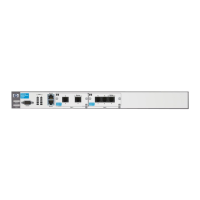13-20
Dynamic Host Configuration Protocol (DHCP)
Managing and Troubleshooting the DHCP Server
Figure 13-5. Viewing DHCP Clients Supported by the Router
Monitoring the DHCP Process
When troubleshooting a router’s DHCP functions, it is often helpful to track
the DHCP process. (To review this process, refer to “DHCP Request Process”
on page 13-3.)
You can view DHCP messages as they arrive on the interface by entering:
ProCurve# debug ip dhcp-server
Caution Debug messages can tie up the router’s processor. Therefore, you should be
very cautious about using them in a live network. You should begin by
troubleshooting the host experiencing the problem and rule out a connectivity
problem.
In a large network, you should not use DHCP debug messages to fix a problem
for a single host. The router may be flooded with DHCP messages from other
hosts, and displaying them all could potentially compromise network
performance.
DHCP messages generally break down into the steps of the DHCP request
process. You can look for a message that repeats several times to determine
where the process begins to break down.
View Table 13-1 for a quick guide to what steps you should take when you see
a debug message repeat again and again.
ProCurveSR7102dl# show ip dhcp-server binding
IP Address Client Id Lease Expiration Client Name
172.16.1.4 01:00:50:04:91:ee:19 Aug 27 2004 3:04 PM HunterPC
172.16.2.28 01:00:01:02:51:c9:f6 Aug 27 2004 3:26 PM ShanePC
172.16.1.7 01:00:10:4b:a0:df:0a Aug 27 2004 3:28 PM TreyPC
User-selected name on the
computer or device
Client’s MAC address

